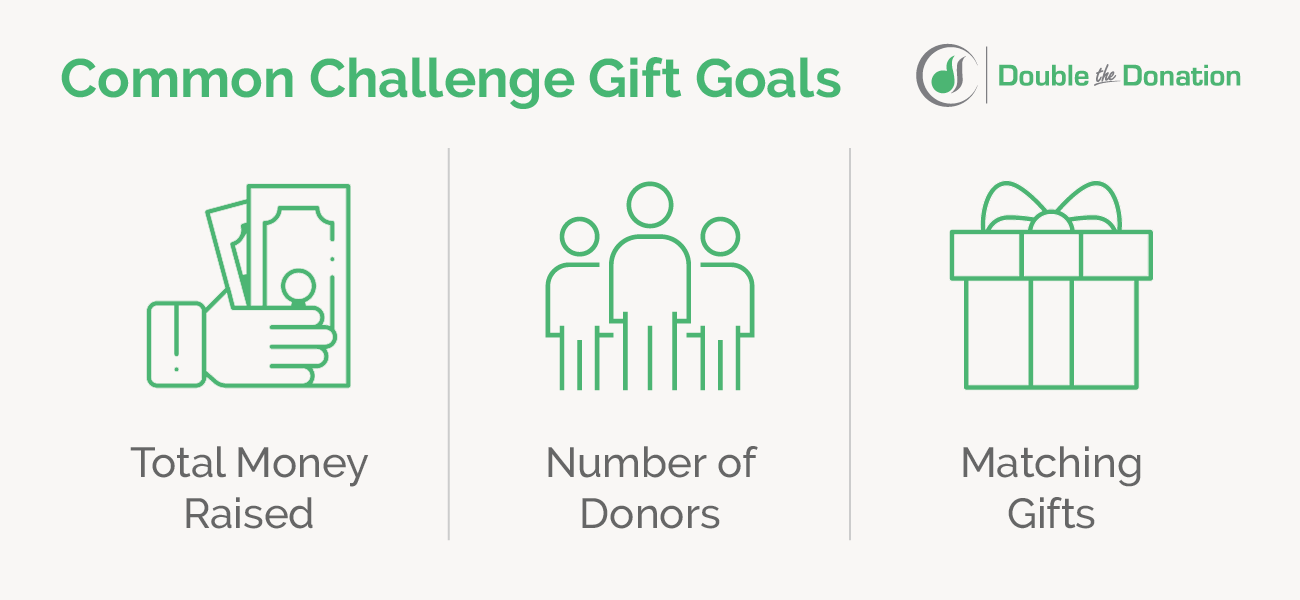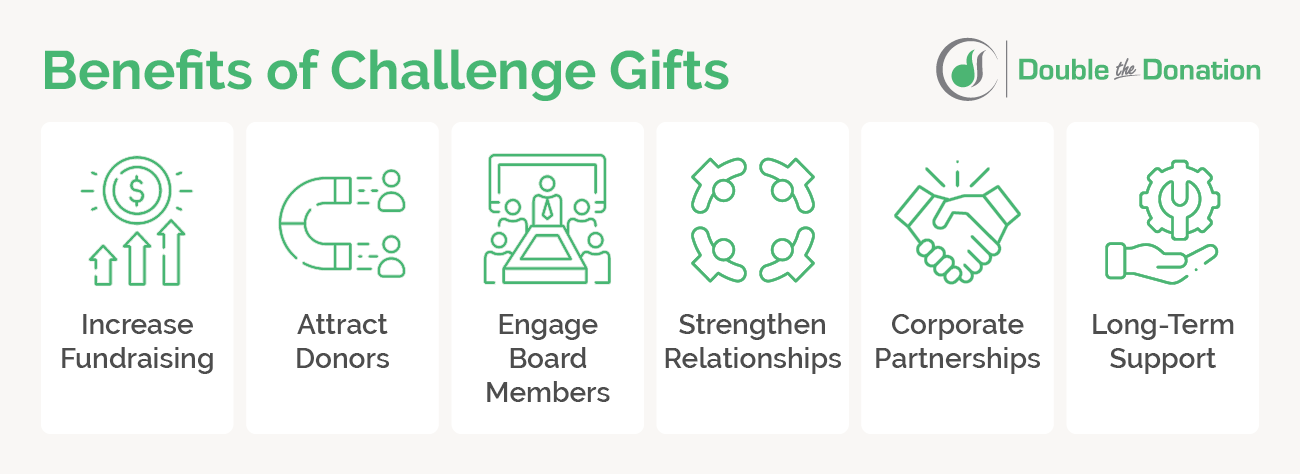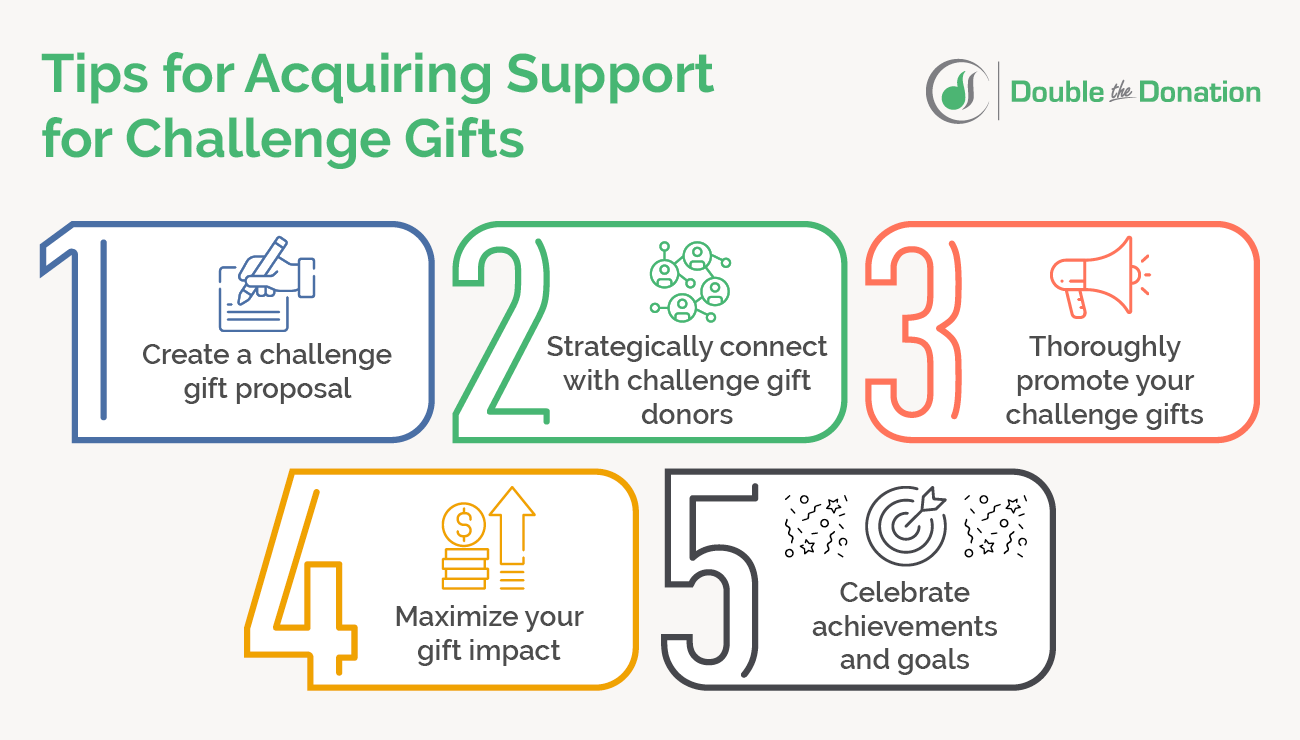What are Challenge Gifts? A Guide to High-Speed Fundraising
A thoughtful and robust fundraising strategy is key to any nonprofit’s success. As a nonprofit professional, you’re probably always on the lookout for new ideas and strategies to spice up your organization’s fundraising efforts. That’s where challenge gifts come in—when done correctly, this fundraising idea can supercharge your mission with increased gifts.
In this guide, we’ll go over the basics of challenge gifts and empower you to leverage them by covering the following topics:
- What is a challenge gift?
- What are the benefits of challenge gifts?
- What are the drawbacks of challenge gifts?
- Getting Support for Your Challenge Gift Campaign: 5 Tips
To maximize the fundraising impact of your challenge gifts, consider investing in fundraising software that will streamline your fundraising processes and efforts. Matching gift software, in particular, will greatly increase the effectiveness of donations made during your challenge gift campaign.
What is a challenge gift?
A challenge gift is a donation that is contingent on another goal, usually another donation. Usually, the donor will commit to donating a certain amount to a nonprofit if the organization or its other donors fulfill a certain goal or take an action within a certain amount of time. Only then is the donation made.
Common challenge gift goals include:
- Total money raised. This goal is fairly self-explanatory—essentially, the donor’s gift hinges on the nonprofit reaching a fundraising goal. For example, a major donor might commit to donating $20,000 if the nonprofit raises $40,000 worth of other donations during their next fundraising campaign.
- Total number of donors. Instead of committing a donation based on the amount raised, some donors choose instead to base it on the total number of donors that give during a set amount of time. The goal for this type of challenge gift is to help the nonprofit recruit more donors. Some challenge donors may specify that they only count first-time donors, while others will count donations made by any donors.
- Matching gifts. For a matching donation challenge, a major donor or sponsor will commit to matching gifts made by other donors. For instance, a major donor may match gifts at a 1:1 ratio up to $30,000. That means that if you raise $30,000 from other donors, then you’ll receive $60,000 in total. However, if you raise less than the match amount, such as $10,000, then you’ll only receive the match up to that amount, or $20,000 total.
Challenge gifts are a great way for a major donor to inspire and encourage other donors to give, resulting in greater fundraising success for the nonprofit. When handled properly, these challenges can be used to secure future support and improve the sustainability of your organization.
What are the benefits of challenge gifts?
At this point, you may be thinking: Aren’t challenge gifts just donations with strings attached? Why would I want those instead of straightforward donations?
Although you might feel that way, challenge gifts bring your nonprofit a variety of game-changing benefits. Some of these include:
- Increase fundraising impact. The most obvious benefit of challenge gifts is that they incentivize supporters to give. Your supporters are invested in your nonprofit’s success, which makes it more likely that they’ll donate so that you can secure challenge gift funds.
- Attract new donors. If the challenge gift is contingent on acquiring a certain number of donors, it will be especially useful in attracting new donors. Plus, challenge gifts inspire a sense of urgency, providing a compelling reason for potential supporters to engage through donations.
- Engage board members. Board members who are passionately invested in your nonprofit’s cause may inspire and engage their fellow board members by making a challenge gift for them. For example, a board member might say that they will give an extra $30,000 if the board as a whole gives $200,000 by a certain date.
- Strengthen existing relationships. The urgency from the time-sensitive nature of challenge gifts will also help you secure donations from previous donors. Alongside a great stewardship plan, challenge gifts can greatly contribute to engaging previous donors and increase retention rates.
- Form corporate partnerships. Although challenge gift donors don’t have to be businesses, if they are, it presents an opportunity for you to form partnerships with companies that are invested in corporate social responsibility (CSR). Having such a partnership may lead to future support through initiatives such as volunteer grants.
- Secure long-term support. Aside from short-term support for immediate fundraising campaigns, certain challenge gifts can also help your nonprofit secure long-term funding. For example, a challenge donor may create a bequest challenge for $50,000. Every time someone submits a signed statement that they have put your nonprofit in their estate plan, the donor will release $2,000 from the challenge gift total.
When it comes to boosting your fundraising and securing support, challenge gifts are a valuable opportunity for nonprofits to reliably meet their goals. While the donor dictates the terms of the challenge, the concept itself has a lot of flexibility, as it accommodates multiple types of challenges.
What are the drawbacks of challenge gifts?
We’ve already touched on the main drawback of challenge gifts—the inability to fulfill the challenge, and therefore the loss of the challenge gift funds. The most common restrictions on a challenge gift include:
- Goal amount. Whether it’s the number of donors or the donation amount, each challenge gift comes with a goal amount that the nonprofit must reach. Without reaching this objective, part or all of the challenge gift might be forfeited.
- Time. That challenge gifts are time-sensitive creates a great sense of urgency that propels supporters to give. However, that same benefit is also a restriction—your nonprofit only has a set amount of time to reach your goals. This duration can vary greatly, based on the challenge the donor has set.
- Donation requirements. These refer to any extra requirements that the challenge donor places on gifts that count toward the challenge gift goal. We’ve discussed that the challenge donor might choose to restrict the type of donor that can participate in the challenge, but they can also restrict the type of donation that qualifies. For example, they might specify that the challenge only applies to direct donations and specify that purchases made at a fundraising auction don’t qualify.
Although challenge gifts have their drawbacks, with proper planning and consideration, you can mitigate their disadvantages. While they might put your nonprofit’s fundraising and donor acquisition strategies to the test, the result will be well worth it—a large amount of funds that you can leverage to support your beneficiaries.
Acquiring Support for Challenge Gifts: 5 Tips
To help you make the most of any challenge gifts your nonprofit receives, we’ll go over five tips for acquiring support to fulfill your challenges. Let’s dive in!
1. Create a challenge gift proposal.
While some donors may make a challenge gift unprompted, it’s more likely that your nonprofit will need to specifically seek out challenge donors, much like you seek out sponsorships. To do so, you’ll want to draft a challenge gift proposal to pitch to potential donors.
As you create your proposal, be sure to:
- Introduce your nonprofit. Provide a general overview of your nonprofit’s mission, beneficiaries, and the purpose of the challenge gift that you’re requesting.
- Give any relevant context. If there’s any relevant information that would help contextualize your proposal, add it. For example, if your nonprofit works with individuals experiencing homelessness and the weather is much colder than usual in winter, you may say that you’re fundraising for warm winter clothing.
- Outline your goals. Whether your goal is to obtain funds, new donors, or bequests, outline it in your proposal. Be specific—for instance, you may say that you want to raise $100,000, attract 500 new donors, or obtain 300 bequests.
- Determine the challenge details. Lay out the general details of your challenge so your potential challenge donor knows exactly what is expected of them. Let’s say you want to raise $100,000. In your proposal, detail that you want to do this through a matching donation challenge, where your challenge donor matches $50,000 worth of donations at a 1:1 ratio to help you meet your overall goal of $100,000.
- Detail the benefits. Aside from describing what you need from your challenge donor, let them know what they’ll be getting from your partnership as well. For instance, if you partner with a company, include their logo and branding on your promotional materials. That way, they can access potential customers amongst your nonprofit’s supporters.
Keep in mind that your challenge gift proposal should look different depending on which potential donor you’re trying to connect with. Just as you would segment your regular donors based on their interests and preferences, make sure to tailor your proposal based on the donor’s gift capacity and previous engagement with your nonprofit.
2. Strategically connect with challenge gift donors.
There are different types of potential donors that you can connect with to pitch challenge gifts to. When first starting, we recommend reaching out to similar types of potential donors to get a better feel of interacting with them and minimize the number of proposals you need to customize.
In general, most challenge gift donors fall into one of the following groups:
- Local businesses. When connecting with local businesses, focus on the benefits that you bring to the local community and how that will bring greater success for the business. For instance, your nonprofit’s environmental focus might enhance a business’ neighborhood and bring in more customers.
- Large corporations. Large corporations will likely have more money to donate as a challenge gift to your cause but require more effort when forming a partnership. Keep your pitch focused on the benefits that they receive from the partnership. This could look like a shoutout from your nonprofit or a mutually beneficial CSR partnership.
- Major donors. Especially if they’ve previously made donations to your nonprofit, major donors are invested in your mission and strongly want you to succeed. For these pitches, you can discuss more in-depth the benefits that your nonprofit will receive while emphasizing how their previous support impacted your success.
- Foundations and grantmakers. For this group of potential challenge donors, you’ll likely go through a rigorous application process to be considered. However, foundations and grantmakers exist to provide support to nonprofits, so you can focus your application on what your nonprofit gains.
- Celebrities and influencers. Celebrities and influencers receive a large boost in reputation for being associated with charitable causes such as your own. Plus, their influence will greatly increase the visibility of your challenge. Be sure to take both of these factors into consideration as you craft your appeal to this group of potential donors.
To help you narrow down the potential donors you should connect with, focus on those who have already indicated a philanthropic interest in some way. For example, businesses with existing corporate citizenship or CSR initiatives that align with your cause will be more open to aiding your nonprofit.
3. Thoroughly promote your challenge gifts.
Ensure that your challenge gifts drive the impact you desire by thoughtfully promoting them to all of your nonprofit’s supporters. Use the following marketing channels to do so:
- Your website
- Direct mail
- Text or SMS
- Social media
Send communications before and during the challenge to drum up excitement and secure support. Provide all relevant details to supporters so they know how they can help. For example, if your goal is to acquire 100 first-time donors, ask your supporters to reach out to their friends and family to appeal for first-time donations. Provide templates for social media posts and emails that they can use to make their appeals easier.
Additionally, be sure to focus your messaging on urgency and speed. Emphasize the approaching deadline and don’t be afraid to send multiple messages during the challenge as reminders. To make this process more efficient, consider using a marketing tool to streamline your promotional efforts.
4. Maximize your gift impact.
When properly planned and marketed, one of the great benefits of challenge gifts is a boost in the number of donations made during the challenge. Maximize the impact of gifts by diving into matching gifts.
If you’re new to matching gifts, they are a form of corporate philanthropy where employers match their employees’ donations to nonprofits. Although most match at a 1:1 ratio, particularly generous companies may match at a higher ratio, such as 2:1 or even 3:1.
This is how it works:
- An employee donates to a nonprofit.
- The employee submits a donation match request to their employer.
- The employer reviews the request.
- The employer approves the match and donates the matching funds to the nonprofit.
As around $4-7 billion of matching gift funds is estimated to go unclaimed every year, it’s clear that one of the biggest obstacles to obtaining matching gift funds is awareness.
During a donation challenge period, you’ll be sending out many communications to supporters to urge them to donate. Maximize the impact of those donations by also reminding supporters to look into their employers’ matching gift programs. With a small amount of effort from them, they’ll be able to greatly increase the funds that you raise. Plus, it won’t require them to gift more of their money!
5. Celebrate achievements and goals.
When the period set by your challenge gift has ended, be sure to celebrate all achievements and goals met with your supporters. Recognize all the donors that have given during this time and thank them for participating in the challenge. Even if you didn’t meet your goals, saying a simple thank you goes a long way toward facilitating long-lasting and fruitful relationships.
If you did meet your goals, then consider hosting a celebration! This can take the form of a donor appreciation event, where you invite all those who gave to come and have fun. Or, if your donors are spread all over the country or the globe, send gifts to them instead. These don’t have to break your budget, as they can be small trinkets or merchandise branded to your nonprofit.
The most important thing here is to let your donors know that your success would not be possible without them. Show your genuine gratitude so that donors are incentivized to continue supporting your mission.
Additional Resources
Challenge gifts are an incredible opportunity for your nonprofit to buckle down and meet its goals. They also incentivize increased giving from your supporters through gamification, making them a worthwhile gift to receive.
If you’re interested in learning more about nonprofit fundraising opportunities, check out the following resources:
- Matching Donation Challenges: A Guide to Increasing Gifts. Matching donation challenges are a challenge gift that focuses on matching donations. Learn more about leveraging this type of challenge to raise more for your cause.
- How to Unlock Corporate Sponsorships: Get More Support. While not all challenge gift donors are corporations, there’s a possibility that you’ll need a business sponsorship to acquire these gifts. In this guide, you’ll discover how to unlock corporate sponsorships.
- Matching Gift Software Vendors: The Comprehensive List. Ready to increase the impact of donations with matching gifts? Check out this list of matching gift software vendors to streamline your processes.









